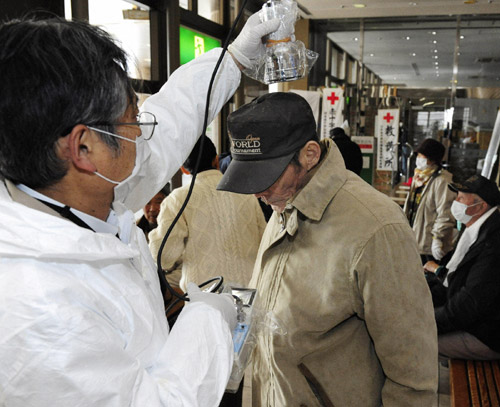Society
Human exposure to radiation
Updated: 2011-03-17 11:29
(WHO)
|
 A man is scanned for radiation at a gymnasium in Fukushima Prefecture, northern Japan March 17, 2011. [Photo/Agencies]
|
What is ionizing radiation?
When certain atoms disintegrate, either naturally or in man made situations, they release a type of energy called Ionizing radiation (IR). This energy can travel as either electromagnetic waves (gamma or X-rays) or as particles (neutrons, beta or alpha).
The atoms that emit radiation are called radionuclides.
The time required for the energy released by a radionuclide to decrease by half (i.e., the "half-life") range from tiny fractions of a second to millions of years depending on the type of atoms.
Human exposure to ionizing radiation
Are people normally exposed to ionizing radiation?
Human beings are exposed to natural radiation on a daily basis. The radiation comes from space (cosmic rays) as well as natural radioactive materials found in the soil, water and air. Radon gas is a naturally formed gas that is the main natural source of radiation.
People can also be exposed to radiation from human-made sources. Today, the most common man-made source of ionizing radiation are certain medical devices such as X-ray machines.
The radiation dose can be expressed in units of Sievert (Sv). On average, a person is exposed to approximately 3.0 mSv/year of which, 80% (2.4 mSv) is due to naturally-occurring sources (i.e., background radiation), 19.6 % (almost 0.6 mSv) is due to the medical use of radiation and the remaining 0.4% (around 0.01 mSv) is due to other sources of human-made radiation.
In some parts of the world, levels of exposure to natural radiation differ due to differences in the local geology. People in some areas can be exposed to more than 200 times the global average.
How are people exposed to ionizing radiation?
Ionizing radiation may result from sources outside or inside of the body (i.e. external irradiation or internal contamination).
Internal contamination may result from breathing in or swallowing radioactive material or through contamination of wounds.
External irradiation is produced when a person is exposed to external sources such as X-rays or when radioactive material (e.g. dust, liquid, aerosols) becomes attached to skin or clothes, resulting in external contamination.
External contamination can often be washed off the body.
What type of radiation exposure could occur in a nuclear power plant accident?
If a nuclear power plant does not function properly, radioactivity may be released into the surrounding area by a mixture of products generated inside the reactor ("nuclear fission products"). The main radionuclides representing health risk are radioactive caesium and radioactive iodine. Members of the public may be exposed directly to such radionuclides in the suspended air or if food and drink are contaminated by such materials.
Rescuers, first responders and nuclear power plant (NPP) workers may be exposed to higher radiation doses due to their professional activities and direct exposure to radioactive materials inside the power plant.
Specials

Earthquake Hits Japan
A massive 8.8 magnitude quake hit the northeast coast of Japan on March 11,2011.

NPC & CPPCC sessions
Lawmakers and political advisers gather in Beijing to discuss major issues.

Pictures: quake aftermath
A massive earthquake hit Japan hard, leaving thousands dead.